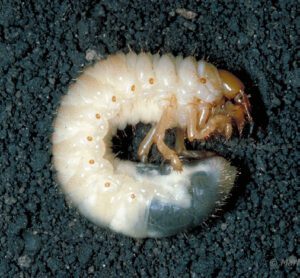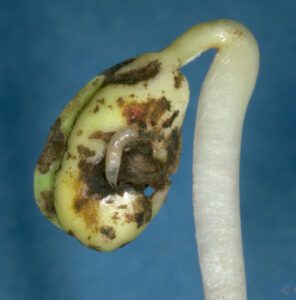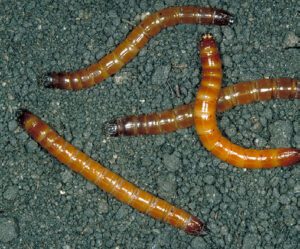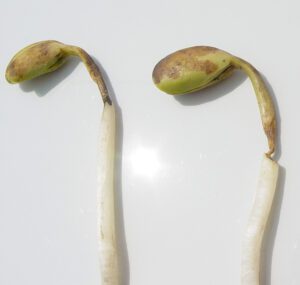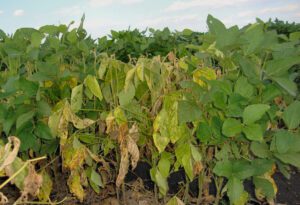Early Season Insect Pests in Soybeans
White Grub
- Often found in lighter textured soils, or near lawns, golf courses, and pasture/hay fields.
- White grubs are white in color with brownish red heads and will curl up in a C shape (see above). They feed on root hairs causing stunted, low-vigor plants.
Seed Corn Maggot
- Potentially problematic in early-planted fields or in cool wet periods when germination is delayed.
- More prevalent in manured fields.
- Maggots are cream or tan in color, headless and legless and feed on germinating soybean seeds or seedlings.
Wireworm
- Often found in well manured fields or fields with sod in the rotation.
- Pale yellow to reddish brown in color, shiny, slender and about an inch long. They bore into the germinating seed or into the base of the seedling plant, killing or weakening it.
Early Season Diseases in Soybeans
- Damping off – the rotting and death of seeds and seedlings – can affect soybean plants prior to or just after emergence.
- Pathogens that can cause damping off, such as Pythium, Fusarium, Phytophthora, and Rhizoctonia are generally favored by wet soils following planting.
Fusarium
- Infection is caused by a complex of different species that prefer different conditions; some prefer warm and dry soils, while others prefer cool and wet soils.
- Some species attack corn, wheat and other host plants.
- Causes light- to dark-brown lesions on soybean roots that may spread over much of the root system.
- May attack the taproot and promote adventitious root growth near the soil surface, and may also degrade lateral roots, but usually does not cause seed rot.
Pythium
- Prefers cold soil temperatures of <59°F (15°C); may be the first soybean disease found in a growing season.
- High-residue fields and heavy or compacted soils are at higher risk because of cooler, wetter conditions.
- Pathogen may attack seeds before or after germination; seeds killed before germination are soft and rotted with soil adhering to them.
- Plants may be killed by “damping off” before or after emergence. On infected plants, the hypocotyl becomes narrow and is commonly “pinched off” by the disease.
Rhizoctonia Root and Stem Rot
- More common in wet soils or moderately wet soils where germination is slow, or emergence is delayed.
- Infection is characterized by a shrunken, reddish-brown lesion on the hypocotyl at or near the soil line.
- Normally appears as the weather becomes warm, around 81°F (27°C); more often seen in late-planted soybean fields.
- Causes loss of seedlings (damping-off) in small patches or within rows; is usually restricted to the seedling stage.
Phytophthora Root and Stem Rot
- Associated with wet soil conditions, commonly occurs on heavy, poorly drained or compacted soils.
- The seedling blight phase occurs at emergence or soon after and is characterized by rapid decay, wilting, and plant death.
- The root and stem rot phase can occur later in development. Symptoms begin in the roots and may spread to the stem.
- Dark-brown to red-brown lesions that may progress up the stem are a key diagnostic feature of the stem rot phase.
- Diseased tissues quickly become soft and water-soaked, and wilting and plant death may soon follow, especially during stress periods.
Influence of Cover Crops and Tillage
- Cover crops can potentially host insect pest species that may damage the subsequent crop. Insect pests that can be associated with cover crops include Japanese beetle, bean leaf beetle, stink bugs, true armyworm, black cutworm, seed corn maggot, and wireworms.
- Reduced tillage and or excess residue on the soil surface can cause soils to be cooler and wetter which slows crop emergence leaving it vulnerable to early season pests.
- Seed treatments are especially important in this kind of seedbed environment to protect seedlings and help ensure that stands are sufficient for highest yields.
Protecting Your Soybean Stand
Variety Selection
Choose varieties with genetic resistance to phytophthora root and stem rot and strong field tolerance ratings. This information is available in your AgVenture seed guide, on the AgVenture website and from your locally owned AgVenture independent seed company.
Seed Treatments
AgVenture offers several soybean seed treatment options to our network of independent seed companies. Ask your local ISC about the Security Seed Protection System™ package that is best for your operation. Our treatment packages, powered by LumiGEN® seed treatments, provide advanced protection against pests, disease and uncertain soil conditions during the critical early growth period.
Lumisena® fungicide seed treatment provides best-in-class protection against Phytophthora, the number one soybean disease. All AgVenture soybean treatment packages feature Lumisena to protect against Phytophthora. If you need to address extra insect pressure, Lumiderm® insecticide seed treatment, which contains a novel Group 28 insecticide mode of action that protects soybean seedlings against several insect pests, is available to add on to any of our seed treatment packages.
Directed Scouting from Granular
Scouting soybean fields for early season pests and disease is easier using Granular Insights Directed Scouting.
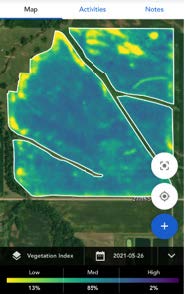 The figure to the right shows a field vegetation index map in the Granular Insights app. The blue/green are areas of the field that are good, whereas the yellow indicates that some scouting is necessary to determine what is hampering the growth in those areas.
The figure to the right shows a field vegetation index map in the Granular Insights app. The blue/green are areas of the field that are good, whereas the yellow indicates that some scouting is necessary to determine what is hampering the growth in those areas.
Soybean growers can use this app to walk to these areas of the field, then take photos or notes about the area.
Information courtesy of Laura Sharpe, Corteva Agriscience Agronomy Information Consultant
